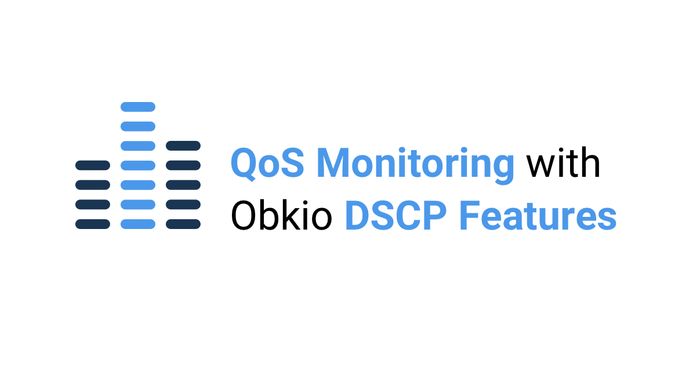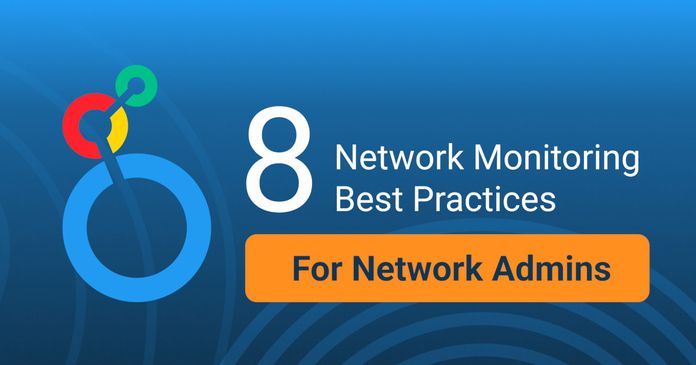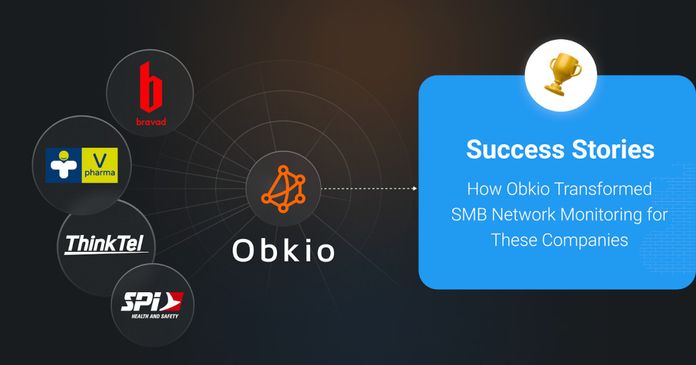Table of Contents
Table of Contents
In today's digital age, network performance monitoring has become a crucial aspect of IT infrastructure management. The ability to monitor and manage network performance is essential for ensuring that networks run efficiently and effectively. Just as Gandalf served as a wise and trusted advisor to the Fellowship of the Ring in J.R.R. Tolkien's "The Lord of the Rings" trilogy, network performance monitoring can serve as a guiding force for IT professionals, helping them to navigate the complexities of modern network environments.
In this extensive article, we will explore the topic of network performance monitoring, including how it works, the key benefits and features, and the types of network performance monitoring tools to help your business improve network performance and end-user experience. By the end of this article, you will have a better understanding of why network performance monitoring is the Gandalf your IT infrastructure needs.
So that we’re all on the same page, let’s start with a general definition of Network Performance Monitoring.
Network Performance Monitoring or NPM refers to the end-to-end monitoring of network performance and end-user experience.
Network performance monitoring (NPM) is the practice of monitoring and analyzing the performance and health of a computer network to ensure it operates efficiently and effectively. It involves the continuous measurement and assessment of various network parameters to identify and resolve issues, optimize network resources, and maintain a high level of service quality. NPM is crucial for businesses and organizations that rely on their networks to support their operations and deliver services to customers and users.
It differs from traditional monitoring because performance is monitored from the end-user perspective, and is measured between two points in the network.
For example:
- The performance between a user, who works in the office, and the application they use in the company’s data center
- The performance between two offices in a network
- The performance between the head office and the Internet
- The performance between your users and the cloud
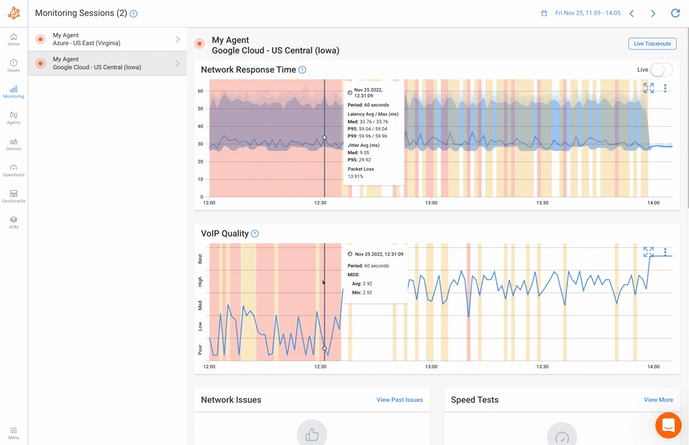
The goal of network performance monitoring is to ensure that the network is operating efficiently and effectively and to identify and address both network availability issues (hard issues) or network performance issues (soft issues) that may arise. This typically involves collecting data on network traffic, bandwidth usage, packet loss, latency, and other key network metrics, as well as using various tools and techniques to analyze and interpret this data.
The information gathered through network performance monitoring can be used to set or raise network performance expectations, troubleshoot and help fix network issues, and make informed decisions about network capacity and infrastructure priorities and planning.
- Traffic Analysis: NPM tools capture and analyze network traffic data, including the volume of data, types of traffic (e.g., web, email, video), and the sources and destinations of traffic. This helps identify patterns and anomalies that may impact network performance.
- Latency Measurement: Latency refers to the delay in data transmission across a network. Monitoring latency helps ensure that data is transmitted quickly and without significant delays, which is especially important for real-time applications like video conferencing and online gaming.
- Packet Loss: Packet loss occurs when data packets are dropped or do not reach their intended destination. Monitoring packet loss helps pinpoint network issues that may lead to data loss and poor application performance.
- Bandwidth Utilization: NPM tools track how network bandwidth is used, identifying which applications or devices are consuming the most bandwidth. This information is valuable for capacity planning and network optimization.
- Device Health: Monitoring the health and status of network devices (routers, switches, firewalls, servers, etc.) helps detect hardware or configuration issues that could impact network performance.
- Security: NPM can also play a role in network security by monitoring for unusual or suspicious network activity that may indicate a security breach or cyberattack.
- Alerting and Reporting: NPM tools generate alerts when predefined performance thresholds are exceeded or when anomalies are detected. They also provide reports and dashboards to help network administrators and IT teams visualize and analyze network performance data.
- Historical Data Analysis: Storing historical network performance data allows organizations to identify trends and patterns over time, enabling better decision-making and proactive network management.
Effective network performance monitoring can lead to several benefits, including improved network reliability, faster issue resolution, better resource allocation, enhanced user experiences, and cost savings through efficient use of network resources. It is an essential practice for maintaining the overall health and functionality of modern computer networks, especially in large enterprises and data-intensive environments.
Stop looking for a Network Performance Monitoring tool

Networks may be complex. But Obkio makes network monitoring easy. Monitor, measure, pinpoint, troubleshoot, and solve network problems.
- 14-day free trial of all premium features
- Deploy in just 10 minutes
- Monitor performance in all key network locations
- Measure real-time network metrics
- Identify and troubleshoot live network problems

Network Performance Monitoring is crucial for several reasons. It is a critical component of network management, enabling organizations to optimize network performance, minimize downtime, and ensure the security and compliance of their networks.
NPM is especially important for any business concerned with the proper functioning of its network and relies on cloud-based applications, Internet web services, or critical applications that transact over the network. It’s mandatory for enterprises with MPLS & SD-WAN networks and multiple internet circuits and breakouts.
Here are some of the key reasons why network performance monitoring is important for businesses:
Improve Network Performance: Network performance monitoring is essential for maintaining a high-performing network - it’s the main reason for being. It allows you to identify and troubleshoot issues to improve network performance.
Proactively Identify Network Issues: Network problems, both network availability issues and performance issues, can and do happen, and they can have a significant impact on operations. So it’s important to proactively identify all network issues before they cause havoc:
- Availability Issues: Availability issues are characterized by a complete loss of connectivity. These types of network failures can be caused by a variety of factors, including physical damage to network infrastructure, fiber cuts, and power outages. While availability issues are bad news for network reliability, they are the easiest to pinpoint and troubleshoot.
- Performance Issues: Network performance issues are more challenging to identify and troubleshoot than availability issues. These failures can be either steady or intermittent, with the latter being the most challenging to identify and troubleshoot. Performance issues can occur anywhere, and they may go undetected for years.
Optimize End-User Experience: Monitor the end-user experience when using network applications and services, and proactively identify and troubleshoot network problems before they frustrate users.
- Get faster resolution of end-user issues
- Improve end-user satisfaction
Increase Network Security: Increased network security by identifying potential security threats, such as unusual network activity or unauthorized access attempts.
- Detect potential security breaches
- Minimize the risk of data loss
- Improve compliance with industry standards and regulations
Capacity Planning and Network Optimization: By analyzing network traffic and resource utilization, network administrators can identify potential bottlenecks to:
- Plan for capacity upgrades to support future growth
- Optimize network performance to handle increasing demands
- Reducing infrastructure costs in the future
Lower Costs and Improved ROI: Network performance monitoring can help lower costs and improve ROI by identifying inefficiencies and optimizing network resources.
- Identify areas with overused or underused resources and make adjustments.
- Improve ROI by ensuring that the network is running at peak performance, which can increase productivity and user satisfaction.
- Reduce the costs associated with network downtime and unplanned network outages.
Enhance Business Continuity: Finally, improving network performance (and user experience) will lead to positive business impacts overall.
- Minimize downtime and service disruptions affecting productivity
- Avoid network failures and performance issues that can cost businesses time and money
- Quickly recover from network issues without needing extra IT resources
Unlock the secrets of network monitoring basics in this article. Dive into everything you need to get started with ease – it's not rocket science!
Learn more

Now let’s go over some of the key features of Network Performance Monitoring that you can leverage to take control for your network performance. Think of these as the weapons in your NPM army.
1. Real-Time Network Performance Monitoring:
Real-time monitoring is a critical aspect of Network Performance Monitoring (NPM) which refers to the continuous monitoring of network performance metrics such as bandwidth usage, latency, packet loss, and other key performance indicators (KPIs) in real-time. It allows IT teams to proactively identify network issues before they affect end-users.
2. Network Traffic Analysis:
Traffic analysis involves the examination and analysis of network traffic to identify and diagnose issues related to network performance, security, and compliance. It involves monitoring and analyzing the flow of data packets on the network to identify potential bottlenecks, congestion, and other performance issues that can impact network performance. This can include analyzing metrics such as bandwidth usage, packet loss, latency, and throughput.
3. Historical Network Performance Data Analysis:
Historical data analysis is a key component in troubleshooting past network performance issues, especially intermittent ones. It involves the collection and analysis of historical performance data over a period of time to identify trends and patterns related to network performance.
This data can then be used to identify patterns and trends related to network performance, such as changes in traffic patterns, peak usage periods, and recurring or intermittent issues. It also allows IT teams to troubleshoot issues that happened in the past, as well as anticipate future network performance issues and plan for capacity upgrades or other network improvements.
4. Network Topology Mapping:
Network topology mapping involves the creation and maintenance of a map or diagram that represents the physical and logical layout of a network. Network topology mapping enables IT teams to visualize and understand the relationships between network devices, applications, and users, which can help IT teams identify potential network performance issues, security threats, and compliance risks.
Once a network topology map has been created, IT pros can use it to identify potential performance bottlenecks, such as overloaded switches or routers, and to optimize network performance.
5. Application Performance Monitoring:
Application Performance Monitoring (APM) focuses on monitoring and analyzing the performance of specific applications running on a network. It involves the monitoring and analysis of application performance metrics, such as response time, latency, throughput, and error rates, to identify issues related to application performance, availability, and user experience.
APM involves collecting data from various sources, including application logs, server logs, network traffic, and user interactions, to provide a holistic view of application performance.
6. SNMP Network Device Monitoring:
Simple Network Management Protocol (SNMP) enables IT teams to monitor the performance and status of network devices/ equipment such as routers, switches, firewalls and access points. SNMP Enable devices can be configured to communicate with an SNMP server that will be responsible to collect valuable data about network device ressource health and usage.

Network performance monitoring is an essential task for any businesses that relies on computer networks for their daily operations. To achieve optimal network performance, businesses use a variety of Network Performance Monitoring tools and techniques to monitor and analyze network traffic, identify bottlenecks, and troubleshoot issues.
One of the most important aspects of network performance monitoring is the use of specialized tools designed to collect and analyze network data in real-time - because you can’t keep an eye on everything by yourself. These tools come in many forms and are used by network administrators, engineers, and IT professionals to monitor network health, troubleshoot issues, and optimize performance.
Here are some of the different types of network performance monitoring tools that are commonly used in modern networks:
Passive network performance monitoring tools collect and analyze data on network traffic as it flows through the network. Unlike active monitoring tools that generate synthetic traffic, passive monitoring tools capture and analyze the traffic that is already flowing through the network.
Passive network performance monitoring tools are typically used to capture network traffic, measure network performance metrics, and provide visibility into network usage patterns.
Passive network performance monitoring tools typically involve:
- Capturing and analyzing real user traffic.
- Analyzing packet headers and payloads to measure network performance metrics such as latency, jitter, and throughput.
- Providing detailed visibility into network traffic patterns, which can be used to identify trends, troubleshoot issues, and monitor application performance.
- Identifying bandwidth-intensive applications, analyzing traffic patterns, and identifying network congestion points or overall network overload.
Passive Network Performance Monitoring tools do have several drawbacks, which is why they are being increasingly replaced by Active Performance Monitoring solutions.
Some drawbacks include:
- Inability to generate traffic: Which means that they may not be able to identify issues that are only present during periods of heavy traffic.
- Limited scope of analysis: As they can only analyze traffic that is captured, which may not provide a complete picture of network performance.
- Resource intensive: They require significant resources to capture and store network traffic, which can result in performance issues on the monitored network.
- Potential privacy concerns: Since they capture all network traffic, including sensitive information such as passwords and confidential data. This can raise privacy concerns if the captured data is not properly secured.
- Complexity: They are complex to configure and use, requiring a high level of technical expertise to interpret the data collected.
Discover the differences, benefits, and implementation strategies of active network monitoring vs passive network monitoring.
Learn more

Active network performance monitoring tools monitor network performance by sending data packets across the network to simulate user traffic and test network performance. These tools are used to actively monitor and measure network performance, identify issues in real-time, and generate alerts when network performance falls below acceptable levels.
Active network performance monitoring tools typically involve:
- Deploying monitoring agents or probes in key network locations for end-to-end monitoring.
- The agents or probes continuously send synthetic data packets across the network to measure network latency, throughput, and packet loss.
- These tools also allow network administrators to simulate user behavior and test how the network responds under different loads and conditions.
Active network performance monitoring tools are also increasingly replacing older Passive monitoring solutions for a variety of reasons, such as:
- Proactive monitoring: They simulate user traffic and continuously monitor the network for potential issues, allowing IT teams to detect and address problems before they impact end-users.
- No packet capture: Active monitoring tools don’t capture real user traffic, which means that there are no privacy concerns related to real-user data. This also means that they can monitor performance even during low-traffic periods.
- Accurate measurements: Active tools can provide accurate measurements of network performance metrics such as latency, bandwidth utilization, and packet loss, as they generate their own traffic and measure the response.
- Complete visibility: Active tools can monitor all components of the network, including servers, switches, routers, and applications, giving IT teams complete visibility into the performance of the entire network.
- Flexibility: Active tools can be customized to meet specific monitoring needs and can be deployed in various locations, including the cloud, on-premises, and remote locations.
- Scalability: Active tools can scale to monitor large and complex networks with multiple locations, making them ideal for enterprise-level organizations.
Some common examples of active network performance monitoring tools include Ping, Traceroute, which are built-in tools available in most operating systems. As well as more advanced commercial tools like Obkio Network Performance Monitoring, which monitors network performance using Monitoring Agents which send synthetic UDP traffic every 500ms between each other in key network locations.
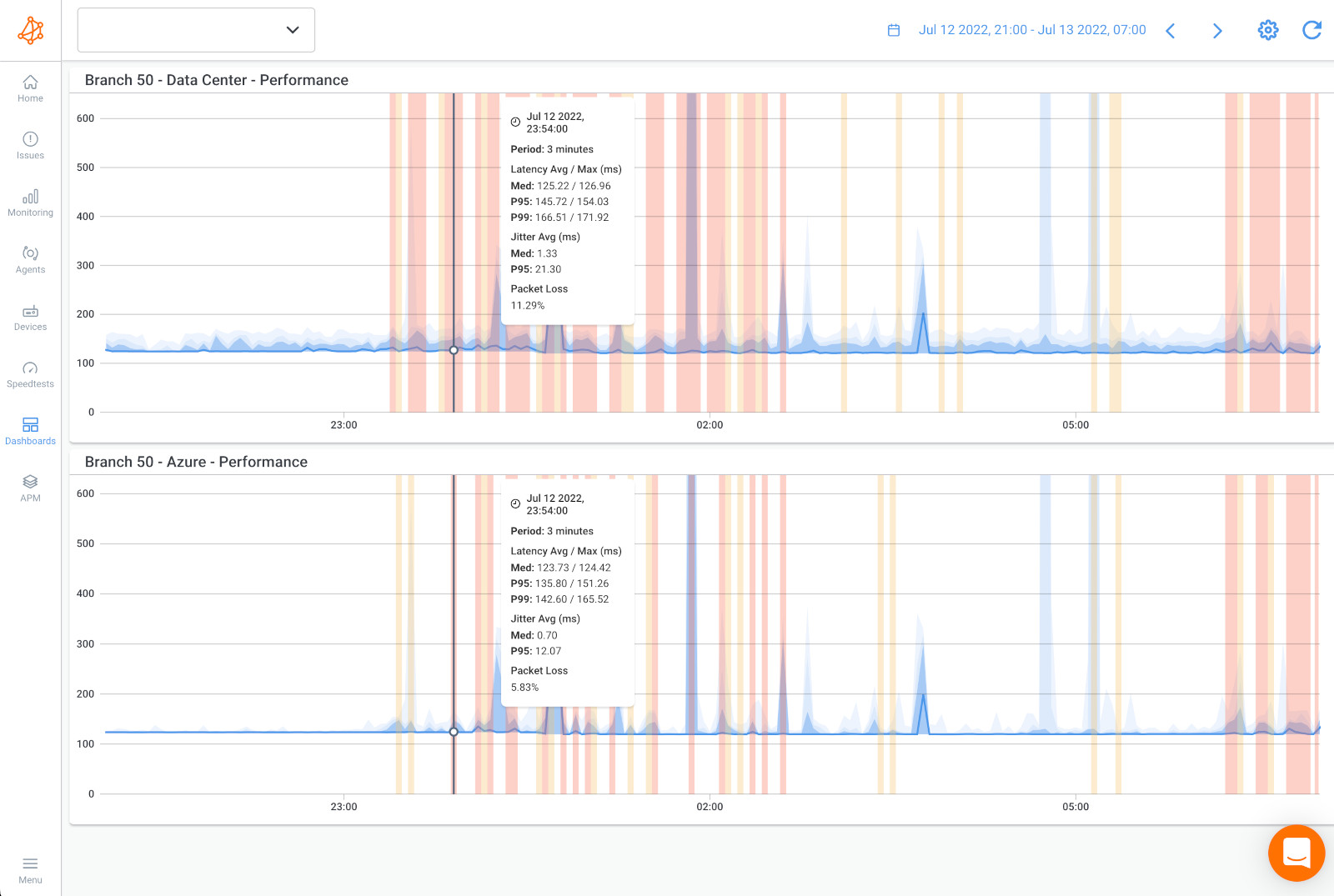
SNMP-based network monitoring tools use the Simple Network Management Protocol (SNMP) to monitor and manage network devices.
SNMP is a protocol used to manage network devices and allows network administrators to monitor and control network devices such as routers, switches, servers, printers, and other network devices. SNMP-based network monitoring tools can collect information about the network devices such as CPU utilization, memory usage, traffic statistics, and other parameters.
This information is then used by network administrators to optimize network performance, troubleshoot network problems, and plan network upgrades. SNMP-based monitoring tools can be either active or passive, and can be used to monitor both wired and wireless networks.
Network Performance Monitoring tools like Obkio, also have SNMP Network Device Monitoring capabilities, which allow you to have a network, application, and network device monitoring solution in one.
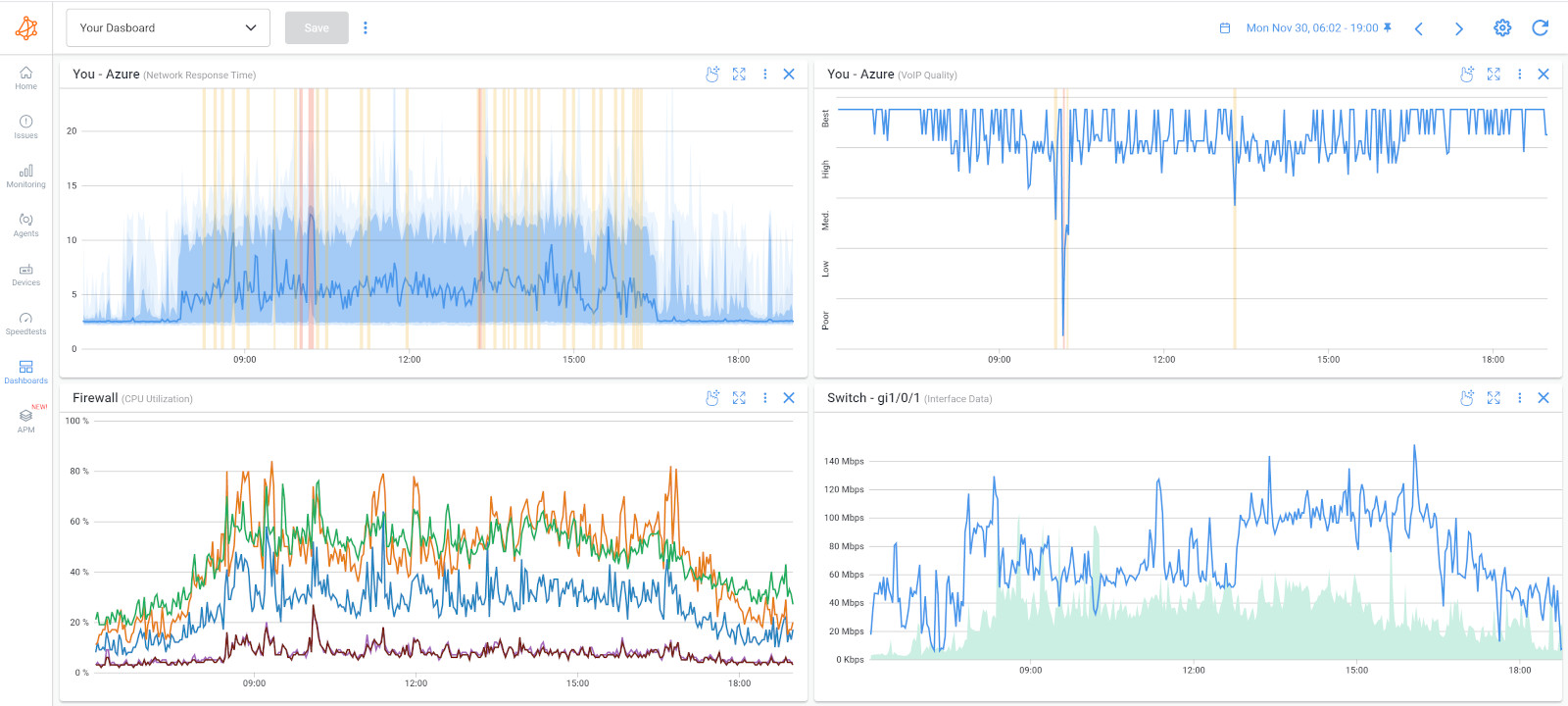
Application Performance Monitoring (APM) tools are software programs designed to monitor the performance and availability of applications in real-time. APM tools are used to identify, diagnose, and resolve performance issues that affect application performance and user experience.
APM tools provide visibility into the entire application stack, including the application code, web servers, databases, and other infrastructure components by collecting various metrics related to application performance, such as response times, throughput, error rates, and resource utilization, to provide insights into application behavior and help optimize performance. They also have features such as application mapping, transaction tracing, and code-level diagnostics to help identify and diagnose performance issues.

End-User Experience Monitoring (EUEM) tools are designed to track the experience of end-users while they are using an application or accessing a website. They provide visibility into how applications and services are performing for end-users, regardless of where they are accessing them from, and can help identify and troubleshoot issues related to network performance.
EUEM tools collect data on a variety of user experience metrics, including page load times, response times, and error rates, among others. Some EUEM tools also offer the ability to simulate user interactions with applications, allowing IT teams to identify potential issues before they impact end-users.
Synthetic Network Performance Monitoring tools are designed to simulate user behavior on a network to measure network performance. These tools generate synthetic traffic that is sent over the network and measure various performance metrics, such as latency, packet loss, and jitter.
Synthetic monitoring tools are used to test the performance of new network infrastructure, as well as identifying and diagnosing problems in existing network infrastructure. They can also be used to simulate real-world scenarios, such as heavy user loads or specific types of network traffic, to test the network's performance under different conditions.
Active Network Performance Monitoring tools are oftentimes also synthetic monitoring tools. A tool like Obkio generates synthetic UDP traffic to measure network performance every 500ms.
Overall, synthetic network performance monitoring tools provide a way to proactively monitor and test network performance to ensure optimal network operation.
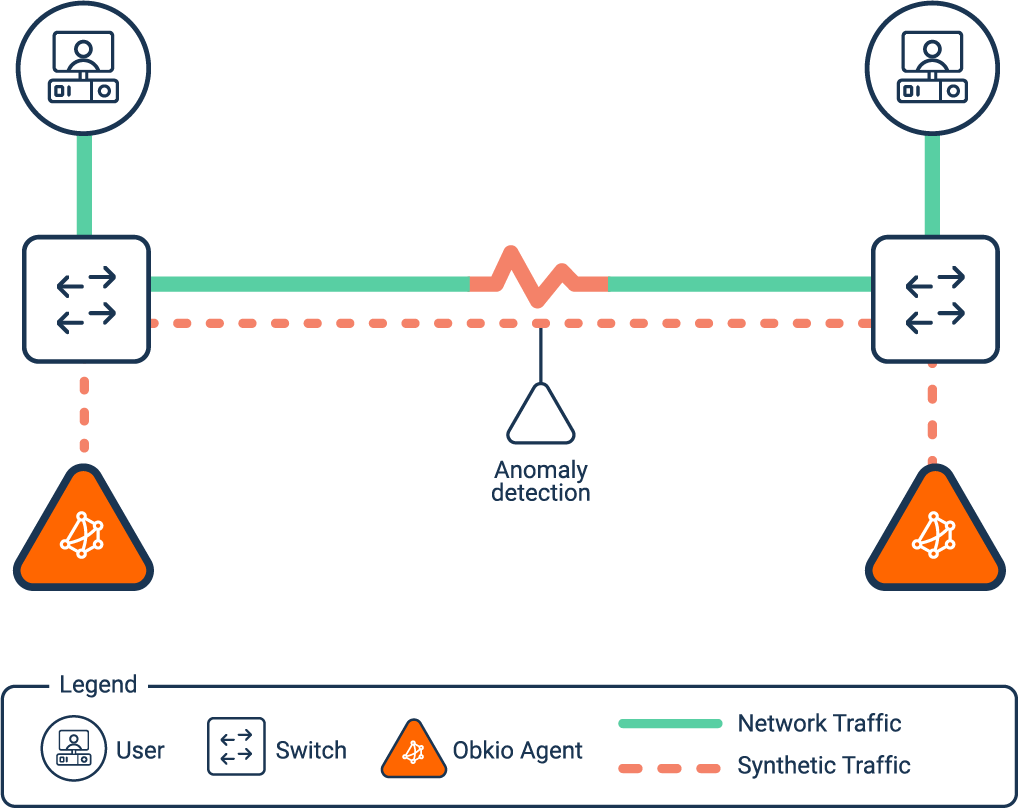
Network packet analyzers, also known as packet sniffers, protocol analyzers, or network analyzers, capture and analyze the data packets sent and received over a network. It allows network administrators and security professionals to examine the network traffic, identify the source and destination of the packets, and analyze the content of the packets to troubleshoot network issues, optimize network performance, and detect and prevent security threats.
Packet analyzers can be used in wired and wireless networks, and they support a variety of network protocols and interfaces, such as Ethernet, Wi-Fi, TCP/IP, and HTTP.
Flow-based network monitoring tools collect information about network traffic by analyzing flow data. Flow data is metadata that describes the characteristics of network traffic, such as the source and destination IP addresses, port numbers, and the amount of data transmitted.
Flow-based monitoring tools use this information to identify the types of traffic that are traversing the network, as well as the endpoints generating and receiving the traffic. This allows network administrators to identify which applications are consuming the most bandwidth, track usage patterns, and troubleshoot network issues.
Cloud-based network monitoring tools allow for network performance monitoring from a remote location. They are hosted in the cloud and use a network of servers to collect and analyze data on network traffic, application performance, and other relevant metrics.
Cloud-based network monitoring tools can be accessed through a web interface, making it easy for IT professionals to monitor their network's performance from anywhere with an Internet connection. They are also often subscription-based, and they can offer features such as real-time monitoring, alerts, and reporting. They can also scale easily to accommodate growing networks and offer high availability and reliability and help organizations reduce their IT infrastructure costs by eliminating the need to purchase and maintain hardware and software on-premises.
Wi-Fi Performance Monitoring Tools monitor and analyze the performance of Wi-Fi networks. They capture and analyze data from Wi-Fi devices and access points, providing insights into various Wi-Fi performance metrics such as signal strength, throughput, latency, and packet loss.
Wi-Fi Performance Monitoring Tools help identify and troubleshoot Wi-Fi performance issues, optimize Wi-Fi network performance, and ensure high-quality Wi-Fi service delivery to end-users.
Choose your Ultimate Fighter: Network Performance Monitoring tool to ensure optimal network performance. Learn about the types of tools, features & uses.
Learn more

As you can see, there are many types of tools you can use to monitor your network, device, and application performance. The one you use will depend on your network’s and business’ needs and resources.
Keep in mind that many tools on the market can actually have features from many of the different tools listed above. For example, Obkio’s Network Performance Monitoring tool is an active monitoring tool that uses synthetic testing to monitor network, application, Internet and network device (SNMP) performance all in one.

Network Performance Monitoring (NPM) and Network Performance Management (NPM) are two essential practices in the field of network management. While they share the common goal of optimizing and maintaining network performance, they differ in their scope and objectives.
NPM is primarily focused on real-time monitoring and troubleshooting, providing immediate insights into network issues, while NPM takes a broader, long-term view, involving strategic planning and optimization to ensure the network's efficiency and effectiveness over time. In the following sections, we will explore each concept in more detail, highlighting their key functions, emphasis, and use cases."
- Scope: NPM primarily deals with the real-time monitoring and measurement of network parameters and metrics to understand the network's current state.
- Function: NPM tools continuously collect and analyze data about the network's performance. This data includes metrics like bandwidth utilization, latency, packet loss, and device health. The main purpose is to detect issues and anomalies as they occur, providing network administrators with immediate visibility into what is happening on the network.
- Key Emphasis: Real-time monitoring, alerting, and troubleshooting are the key focuses of NPM. It's all about quickly identifying and addressing network problems to maintain service quality.
- Use Cases: NPM is essential in scenarios where it's critical to ensure that network services run smoothly at all times. For example, in a data center or a cloud MSP network, any downtime or performance degradation can have significant financial and operational consequences. NPM tools help in quickly diagnosing and resolving these issues.
The choice between Network Performance Monitoring (NPM) and Network Performance Management (NPM) depends on your specific network management needs and objectives. Here's a guideline on when to use each type:
When to Use Network Performance Monitoring (NPM):
- Immediate Issue Resolution: Use NPM when your primary concern is the quick identification and resolution of network performance issues as they occur. NPM tools provide real-time visibility into the network's current state, allowing you to address problems promptly.
- Maintaining Service Quality: NPM is crucial in scenarios where network downtime or performance degradation can have immediate and significant consequences. For example, in data centers, cloud service providers, or critical infrastructure networks, NPM helps ensure uninterrupted service.
- Troubleshooting: Whenever network issues arise, NPM tools are essential for troubleshooting. They provide detailed insights into metrics like latency, packet loss, and bandwidth utilization, aiding in the diagnosis and resolution of problems.
- Continuous Monitoring: If your goal is to keep a constant eye on network health and quickly respond to anomalies, NPM is the right choice. It's particularly valuable for IT teams responsible for maintaining network uptime and reliability.
- Scope: Network Performance Management encompasses a broader set of activities and strategies related to managing network performance.
- Function: Network Performance Management involves not only real-time monitoring but also long-term planning and optimization of the network. It includes historical data analysis, capacity planning, traffic optimization, resource allocation, policy enforcement, and even network design changes. The goal is to improve network performance over the long term by making informed and strategic decisions based on comprehensive data analysis.
- Key Emphasis: The primary focus of Network Performance Management is on long-term planning, optimization, and strategic decision-making. It's about ensuring that the network is not only responsive to immediate issues but also capable of meeting future demands.
- Use Cases: Network Performance Management is particularly valuable for organizations that need to align their network infrastructure with their business objectives and future growth. It helps in making decisions related to network upgrades, expansion, resource allocation, and technology adoption. For example, a telecommunications company might use NPM to plan for the rollout of 5G services by analyzing historical data and predicting future network requirements.
When to Use Network Performance Management (NPM):
- Long-Term Planning: Consider NPM when you need to make strategic decisions about your network's future. This includes capacity planning, network expansion, technology adoption, and aligning the network with business growth objectives.
- Resource Optimization: NPM is valuable for optimizing network resources over time. It helps in identifying underutilized resources, reallocating bandwidth or hardware, and ensuring efficient use of network assets.
- Policy Enforcement: When you want to enforce network policies and quality of service (QoS) rules to ensure that critical applications receive priority and non-essential traffic is managed effectively, NPM plays a crucial role.
- Historical Data Analysis: NPM tools are essential for analyzing historical network performance data. This analysis helps identify trends, plan for future network upgrades, and make data-driven decisions.
- Proactive Management: Use NPM for proactive network management. Instead of reacting to issues as they arise, NPM allows you to anticipate potential problems, plan for network growth, and optimize the network's performance over the long term.
Network Performance Monitoring (NPM) is concerned with real-time visibility and immediate issue resolution, while Network Performance Management takes a more holistic approach, incorporating long-term planning and strategic decision-making to ensure the network remains efficient and effective over time.
Both are critical aspects of network management, and many organizations use a combination of tools and strategies to maintain the health and performance of their networks.


Network performance metrics are essential for measuring and analyzing the performance of a network. Think of them as the vital signs for a network, much like the vital signs that a doctor monitors to assess a patient's health. Just as a doctor tracks indicators such as heart rate, blood pressure, and oxygen levels to gauge a patient's well-being, IT teams monitor network performance metrics to assess the health of a network.
There are a wide variety of network performance metrics that can be monitored, each providing a different perspective on network performance. Here are some of the most common network metrics involved in Network Performance Monitoring:
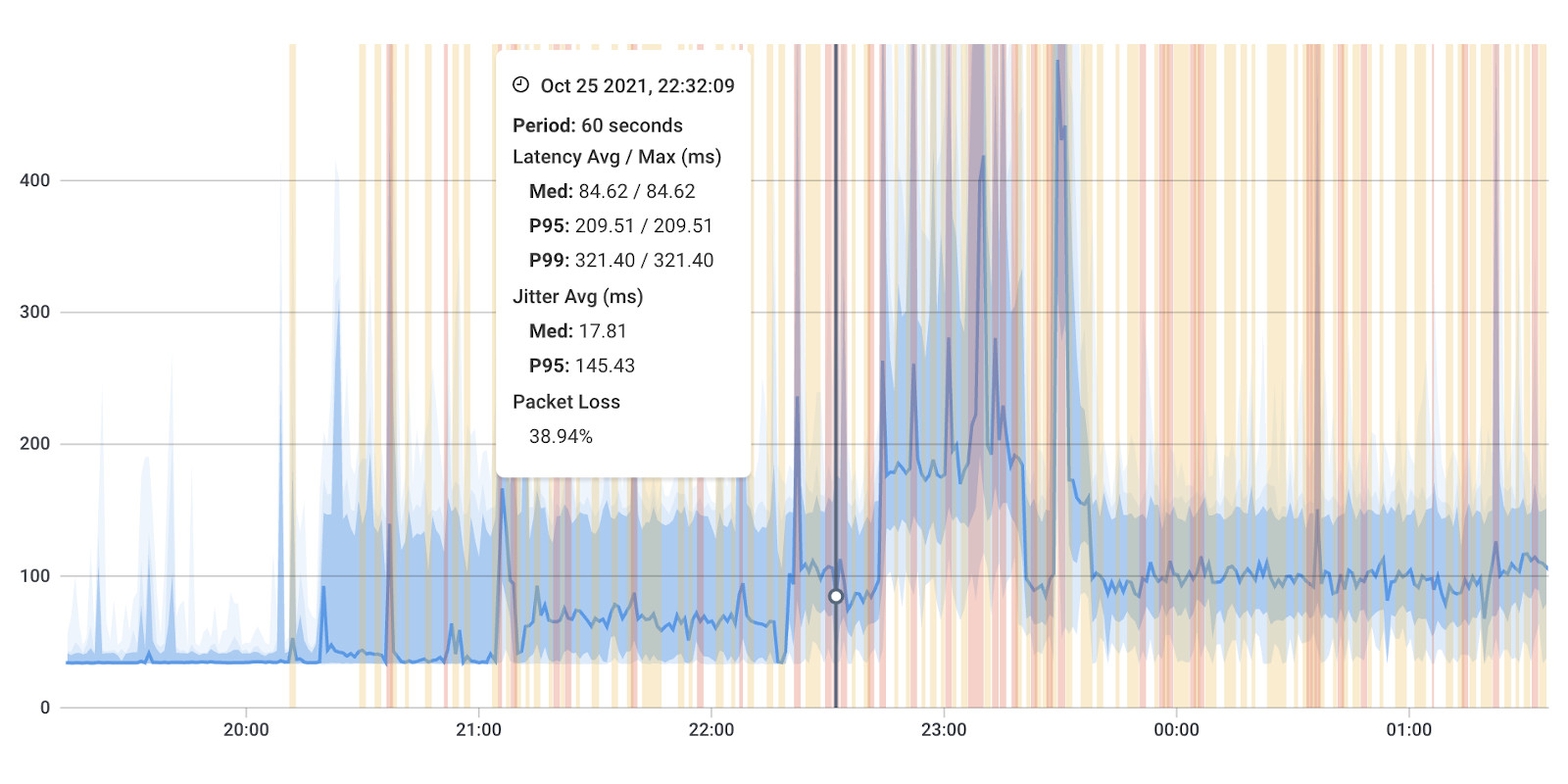
Network availability is a key metric used in network performance monitoring to measure the percentage of time that a network is available for use. It is calculated by dividing the total amount of time that a network is available by the total amount of time in a given period and is usually expressed as a percentage, with a goal of achieving 100% availability.
In opposition to network availability, network performance measures more than if the network is available (up) or down. It measures the percentage of time that a network is performant and offers great user experience. It is calculated by dividing the total amount of time that a network is performant by the total amount of time in a given period and is usually expressed as a percentage, with a goal of achieving 100% availability.
However, in reality, no network can guarantee 100% availability or performance due to factors such as maintenance downtime, hardware failures, and all types of issues that can affect network performance.
To measure network availability or performance, IT teams use Network Performance Monitoring tools like Obkio that track the uptime and downtime of network devices and services.
Packet loss refers to the percentage of data packets that are lost or dropped during transmission over a network. In other words, it is the number of packets that are not successfully transmitted to their destination. Packet loss is generally measured as a percentage of the total number of packets sent versus those received.
In general, a low packet loss rate is desirable for optimal network performance. An acceptable packet loss rate can vary depending on the type of network and the specific application or service being used. However, as a general rule of thumb, a packet loss rate of 1% or less is considered acceptable for most networks and applications.
To measure packet loss, use A Network Performance Monitoring tool, like Obkio, which continuously measures packet loss by sending synthetic UDP packets every 500ms, and recording how many packets are dropped in transmission.
Explore what is packet loss, how packet loss impacts network performance, and how to reduce packet loss to minimize its impact on businesses.
Learn more

Jitter refers to the variation in the delay of received data packets as they travel through a network. It is a measure of the variability of the latency experienced by packets as they traverse a network. Jitter is typically measured in milliseconds (ms) or microseconds (µs), and is caused by a variety of factors such as network congestion, packet loss, and out-of-order packet delivery.
High levels of jitter can lead to poor network performance, particularly for real-time applications such as voice and video conferencing, where the timely delivery of packets is crucial. This can result in choppy audio or video, delays, and poor user experience.
To measure jitter, IT teams use network performance monitoring tools that measure the difference in delay between packets as they travel across a network.
Network latency, also known as network delay, refers to the amount of time it takes for a data packet to travel from its source to its destination across a network. It is one of the key metrics used in network performance monitoring to assess the responsiveness of a network. Latency is typically measured in milliseconds (ms) or microseconds (µs), and can be affected by a variety of factors such as network congestion, packet loss, and distance between network devices.
Network Latency can have a significant impact on network performance, particularly for real-time apps like VoIP and video conferencing and can cause delays, lag, and poor performance, leading to a poor user experience and decreased productivity. This is why monitoring latency is key to understanding network performance.
To measure network latency, IT teams can use network performance monitoring tools that measure the round-trip time (RTT) for data packets between network devices. RTT is the time it takes for a data packet to travel from its source to its destination and back again.
Round-Trip Time (RTT) is a metric used to measure the time it takes for a packet to travel from the source to the destination and back again. It is related to Latency, and is typically measured in milliseconds (ms).
RTT is an important metric for assessing network performance, particularly for real-time applications such as voice and video conferencing, where low latency is crucial. High RTT values can indicate network congestion or other issues that may impact the performance of these applications.
To monitor RTT, network performance monitoring tools send packets between endpoints and measures the time it takes for the packets to travel from the source to the destination and back again.
Network bandwidth and network throughput are often used interchangeably in the world of networking, but they are not the same thing. While both terms refer to the amount of data that can be transmitted over a network or communication channel, they are measured in different ways and serve different purposes.
- Bandwidth refers to the maximum amount of data that can be transmitted over a network connection in a given period of time. It is typically measured in bits per second (bps) or bytes per second (Bps). For example, a network connection with a bandwidth of 100 Mbps can transmit 100 million bits of data per second.
- Throughput is the actual amount of data that is successfully transmitted over a network connection in a given period of time. It is also measured in bits per second or bytes per second. The throughput of a network connection can be affected by a number of factors, including network congestion, packet loss, and network latency.
Both measuring throughput and measuring bandwidth are important for understanding the performance of a network or communication channel, but they serve different purposes and are used in different contexts.
To measure network throughput and bandwidth, use network performance monitoring tools, like Obkio, that measure the amount of data that is transmitted over a network in a given period of time.
The Bandwidth Utilization metric is a measure of how much of the available network bandwidth is being used at any given time. It is a key metric used in network performance monitoring to assess how efficiently a network is being utilized. Bandwidth Utilization is typically measured as a percentage of the available bandwidth, and can be monitored in real-time or over longer periods of time to identify trends and patterns in network traffic.
High levels of Bandwidth Utilization can indicate network congestion or other issues that may impact network performance, while low levels of Bandwidth Utilization may indicate that the network is underutilized and could potentially benefit from additional traffic.
To monitor Bandwidth Utilization (and measure bandwidth in general), IT teams use network performance monitoring tools that track the amount of data being transmitted across the network, as well as the available bandwidth.
Network Congestion occurs when throughput or usage is higher than the available speed. As a simple rule, bandwidth usage should never be more than 80 % of a circuit speed. Measuring this metric in network performance monitoring allows you to understand the level of network congestion or the amount of traffic that exceeds network capacity at a given point in time.
High levels of network congestion can cause network performance to degrade, impacting application and service availability, and user productivity. By monitoring the network congestion metric, IT teams can identify potential congestion issues and take proactive steps to optimize network performance, such as deploying additional network resources or prioritizing traffic.
To measure network congestion, use network performance monitoring tools that track the volume of data flowing through the network, the number of packets being dropped due to WAN or LAN congestion, and the percentage of available bandwidth.
Learn how to detect network congestion & perform a network congestion test inside & outside your network with Network Monitoring & Network Device Monitoring.
Learn more

Network utilization refers to the amount of network capacity that is being used at a given time. It is expressed as a percentage of the total network bandwidth available. High network utilization can lead to network congestion, packet loss, and reduced network performance. By monitoring network utilization, IT teams can identify potential bottlenecks or congestion issues and take proactive steps to optimize network performance.
Network utilization can be measured at various points in the network, including individual devices, network segments, and the entire network to identify where network resources are being consumed and take action to optimize network performance.
To monitor network utilization, IT teams use network performance monitoring tools with SNMP features that collect data on network traffic and bandwidth usage to identify trends and patterns in network utilization to minimize high resource utilization in their network.
Network Error Rate is a metric used in network performance monitoring to measure the percentage of packets that are lost or corrupted during transmission across a network. Packet errors can occur due to a variety of factors, including network congestion, packet collisions, and hardware malfunctions. High levels of packet errors can lead to poor network performance, reduced throughput, and overall degradation of the user experience.
To monitor error rate, IT teams use network performance monitoring tools that track the number of packets sent and received, as well as the number of packets that are lost or corrupted.
The TCP (Transmission Control Protocol) Retransmission Rate is a metric used in network performance monitoring to measure the percentage of TCP packets that are retransmitted due to errors or congestion on the network. The TCP Retransmission Rate metric measures how often retransmissions occur, as a percentage of the total number of packets transmitted.
A high TCP Retransmission Rate can indicate network congestion, packet loss, or other issues that may impact network performance. By monitoring this metric, IT teams can identify potential issues and take proactive steps to optimize network performance, such as increasing available bandwidth or addressing network congestion.
You can monitor TCP Retransmission Rate, using passive network performance monitoring tools that capture and analyze TCP packet transmissions, track the number of packets sent, the number of packets received, and the number of packets retransmitted.
The DNS (Domain Name System) Resolution Time metric is used to measure the time it takes for a DNS query to be resolved by the DNS server. DNS resolution is the process of translating human-readable domain names, such as www.example.com, into IP addresses, such as 192.0.2.1, that can be understood by computers.
DNS resolution time can impact overall network performance and user experience, particularly for web-based applications and services. A slow DNS resolution time can result in slower page load times, delays in accessing applications, and other performance issues.
Few people monitor DNS but when they do it has a huge impact on user performance and it's very simple to set up.
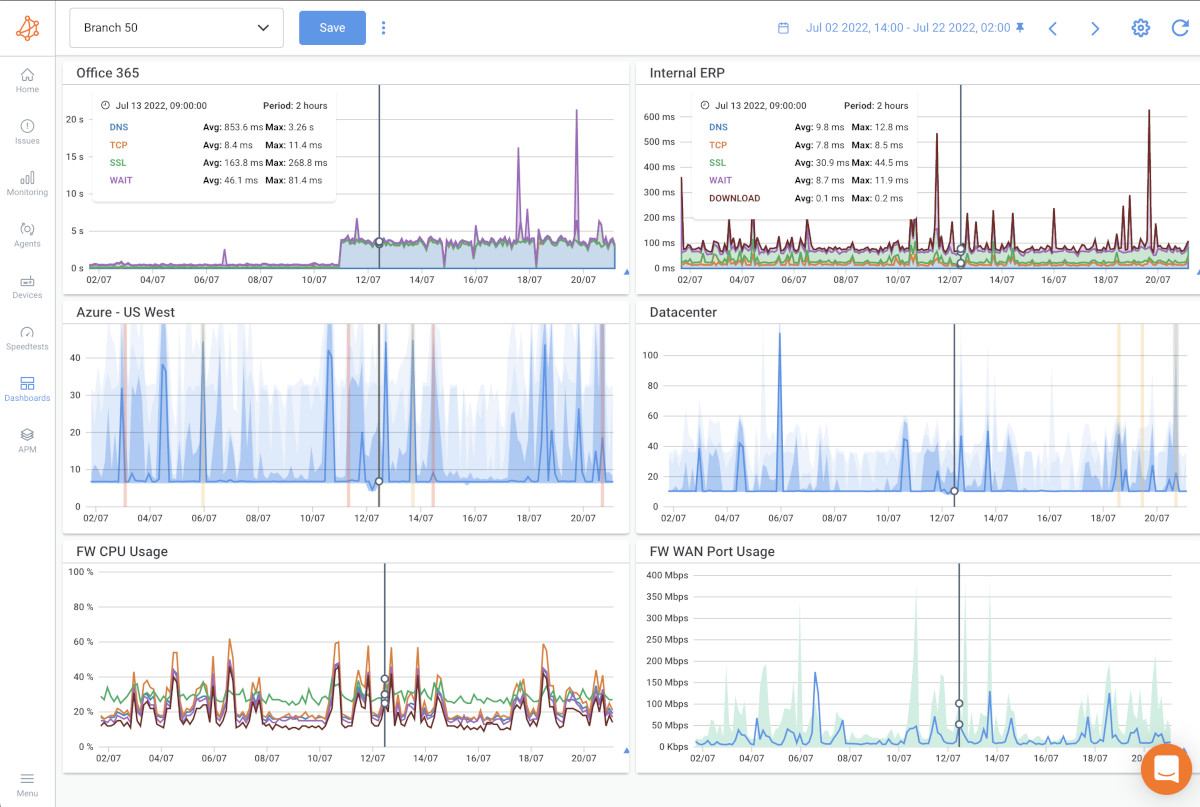
Network Response Time measures the time it takes for a network to respond to a request. Network response time is the time it takes for a network device, such as a server or a router, to respond to a request sent by a client device, such as a computer or a mobile device.
Network response time can impact overall network performance and user experience, particularly for applications and services that rely on real-time interactions, such as video conferencing or online gaming. A slow network response time can result in delays in communication and reduced productivity.
To monitor network response time, use network performance monitoring tools that capture and analyze network traffic, tracking the time it takes for a request to be sent from a client device to a network device and the time it takes for the response to be received.
Server Response Time metric measures the time it takes for a server to respond to a request. This can include the time it takes for the server to process the request, retrieve any necessary data, and send the response back to the client device.
This metric is especially important for web-based applications where the server response time directly affects user experience. Slow server response time can lead to longer page load times, which can negatively impact user experience and lead to a higher bounce rate. Therefore, monitoring server response time is crucial to ensure that web applications are performing optimally.
To monitor server response time, use network performance monitoring tools that collect data on the time it takes for requests to be processed by the server, as well as any delays or errors that occur during the process.
User Quality of Experience (QoE) is a metric used to measure the overall experience of end-users accessing network services or applications. This metric takes into account factors such as network availability, response time, latency, and throughput, as well as the user's perception of the performance of the application or service.
User QoE is important in network performance monitoring because it provides a more holistic view of the user experience beyond technical metrics. It considers the user's perception of the quality of the application or service, which can be influenced by factors such as visual design, ease of use, and the overall performance of the application or service.
To monitor user QoE, use network performance monitoring tools that collect data on technical metrics such as network availability, response time, and latency, as well as user feedback through surveys, feedback forms, or other methods.
Application Performance measures the performance of specific applications running on a network. It considers the performance of the application from the perspective of the end-user and takes into account factors such as response time, latency, throughput, and errors.
Measuring application performance is important in network performance monitoring because applications are often the primary reason for network usage, and poor performance can significantly impact productivity and user satisfaction. By monitoring application performance, IT teams can identify potential issues and take action to ensure that applications are running smoothly and efficiently.
To monitor application performance, use network performance monitoring tools that collect data on technical metrics such as response time, latency, and throughput, as well as application-specific metrics such as number of transactions or requests per second, database query response time, and server load.
Quality of Service (QoS) is a protocol that is used to ensure that certain types of traffic are prioritized over others on a network. QoS allows network administrators to prioritize critical applications, such as voice or video, over less critical applications, such as email or file transfers, to ensure that they receive the necessary network resources to function properly.
QoS can be a powerful tool for managing network traffic, ensuring that critical applications are given priority, and improving the network performance in situations where network resources are limited or congestion is a problem, like QoS for VoIP for example. But it must be configured properly to avoid issues.
Network administrators should carefully monitor QoS settings and adjust them as necessary to ensure that it is working as intended.
Learn how to monitor QoS performance on your private network, including MPLS, SD-WAN, or VPN, using Obkio's DSCP features.
Learn more

Server Uptime/Down measures the availability of servers on a network. It tracks the amount of time a server is operational and available to users (uptime) versus the amount of time it is unavailable or experiencing downtime.
Monitoring server uptime/downtime is important because servers are a critical component of a network infrastructure, providing services and applications to end-users. Downtime can result in lost productivity, decreased customer satisfaction, and lost revenue. By monitoring server uptime/downtime, IT teams can proactively identify and resolve issues before they impact users.
Use network performance monitoring tools that track server uptime/downtime by periodically polling servers to check their availability. They can also use more advanced techniques such as synthetic transactions or real-time monitoring to provide more accurate and timely data.
Effective network performance monitoring is essential for maintaining a healthy and efficient IT infrastructure. It helps organizations detect and resolve issues before they escalate, ensure optimal network performance, and improve end-user experience. From troubleshooting network issues to optimizing network capacity, let’s go through some of the top use cases of network performance monitoring.
Network performance monitoring can be a valuable tool for conducting network audits/assessments. A network audit/assessment is an in-depth analysis of your current network performance to provide you with comprehensive data about your network’s health, including current issues, and any signs of network degradation.
By monitoring key performance metrics such as network availability, latency, throughput, utilization, and error rate, network administrators can gain insight into the overall health and performance of the network, especially before a new service migration (like MPLS to SD-WAN) or deployment (VoIP, UC). Learn more about how to perform a network audit
Network performance monitoring can be used for continuous network monitoring to provide real-time visibility into the performance and health of the network. With continuous monitoring, network administrators can detect and diagnose issues in the network before they become major problems, preventing downtime and improving the overall user experience.
Continuous network monitoring should be used to monitor:
- VoIP Quality (MOS)
- Unified Communication Applications (Zoom, Microsoft Teams)
- SD-WAN Networks
- MPLS Networks
- Dual-WAN Networks
- Cloud Applications and Services (Microsoft Azure, AWS, Google Cloud)
- Internet and Wifi Performance
- SaaS Apps (ERPs and CRMs)
- Network Devices (Firewalls, Routers, Switches, SD-WAN Edge Devices)
- SASE
- VPNs
- Remote Applications, Services and Users
Network performance monitoring can be a valuable tool for network troubleshooting. By constantly monitoring network metrics, such as latency, throughput, and packet loss, performance issues can be detected and diagnosed in real-time. This can help network administrators identify the root cause of the issue and take appropriate actions to resolve it.
Accelerate and simplify the troubleshooting process by identifying network problems, including:
- Where network problems are located (WAN, LAN etc.)
- When they happened
- What caused them
- The owner of the problems (user, application, network, or ISP) who is responsible for fixing them
By using network performance monitoring tools that provide alerts and notifications for network events, administrators can quickly respond to issues and troubleshoot problems more efficiently.
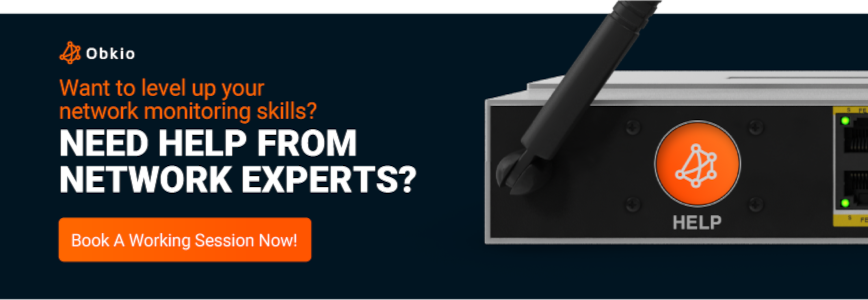
To help you actually start monitoring your network assessment, here are some best practices to follow:
Choosing the right network performance monitoring tool can be a challenging task, particularly given the range of options available on the market today. The buying process involves careful consideration of factors such as your business’ network monitoring use case, goals, requirements and budget.
- Identify your network monitoring use case
- Conduct a network assessment. You can refer to our Network Assessment Template to help you out.
- Determine the target network location where you want to increase visibility
- Test more than one solution for optimal buying process decision
- Plan a budget and ensure staff availability to complete the test
- Ensure that the network performance monitoring tool is integrated with other network management tools to provide a comprehensive view of the network
- Ensure that the network performance monitoring tool is scalable to monitor the complete network infrastructure
Explore essential network monitoring best practices for network admins, from choosing the right tools to troubleshooting internal and external issues.
Learn more

Once a network performance monitoring tool has been selected, the next step is to test it through a Proof of Concept (POC) and implement it. The POC helps to validate the functionality and effectiveness of the tool in a real-world setting, while the implementation process ensures that the tool is configured correctly and integrated with existing network infrastructure. In this section, we will explore the key considerations and best practices for conducting a successful POC and implementing a network performance monitoring tool.
- Deploy the solution according to the use case
- Analyze data and take action to solve network issues from detected events
- Verify if the promised outcomes are achieved
- Validate ease of use and the report on time invested and results obtained
- Compare the results of different solutions and choose the best one
- Purchase the best solution


After purchasing and implementing a network performance monitoring tool, it is important to continue to monitor and optimize its performance to ensure that it delivers the expected benefits. The post-purchasing process involves ongoing monitoring, analysis, and maintenance of the tool, as well as continuous improvement to ensure that it remains effective in meeting the evolving needs of the network.
- Complete deploying the solution and give access to and onboard all IT staff
- Configure network monitoring alerts and notifications to quickly respond to network issues
- Regularly review and analyze network performance data to identify trends and potential issues
- Regularly update the network performance monitoring tool to ensure that it is using the latest technology and features (if taken care by the clients)
- Implement security best practices to protect the network performance monitoring tool from unauthorized access and data breaches
- Monitor the network continuously to detect and troubleshoot network issues in real-time
Network Performance Monitoring Implementation: How to Implement Network Performance Monitoring Step-By-Step
Now that we’ve gone over everything you need to know about Network Performance Monitoring, I’m sure you’d like to know how you can actually monitor your network performance. We’ve covered a variety of different tools and techniques in this article, but to get you started, we’re going to use one of the easiest and most complete Network Performance Monitoring tools on the market.
We recommend an Active, Synthetic agent-based tool, like Obkio Network Performance Monitoring, to measure end-to-end network performance. Here are some reasons why:
- Obkio is SaaS-based: So it can be deployed in 10 minutes and doesn't require any special configurations. This means that you can start monitoring network performance quickly, and can easily scale the solution to your business’ needs.
- End-to-End: Obkio measures every end of your network, from LAN monitoring to WAN monitoring, using Network Monitoring Agents. You can deploy Agents in all your branch offices, remote locations, data centers, Clouds and over the Internet. It can also support all network types.
- Synthetic Monitoring: Obkio measures network performance using synthetic UDP traffic, which means there’s no packet capture required and no privacy concerns for users.

To begin monitoring network performance using an Agent-based network monitoring approach, you need to deploy Network Monitoring Agents which continuously measure network performance in key network locations. Here’s what we recommend:
- Local Agents: Installed in the targeted office location experiencing connectivity issues. There are several Agent types available (all with the same features), and they can be installed on MacOS, Windows, Linux and more.
- Public Monitoring Agents: Which are deployed over the Internet and managed by Obkio. They compare performance up to the Internet and quickly identify if the problem is global or specific to the destination. This will be great information for later in the troubleshooting process. You can use an AWS or Google Cloud Agent.

Once you’ve deployed your Network Performance Monitoring tool, Obkio’s Monitoring Agents will start exchanging traffic to measure network metrics like jitter, packet loss, and latency and display them on Obkio’s Network Response Time Graph.
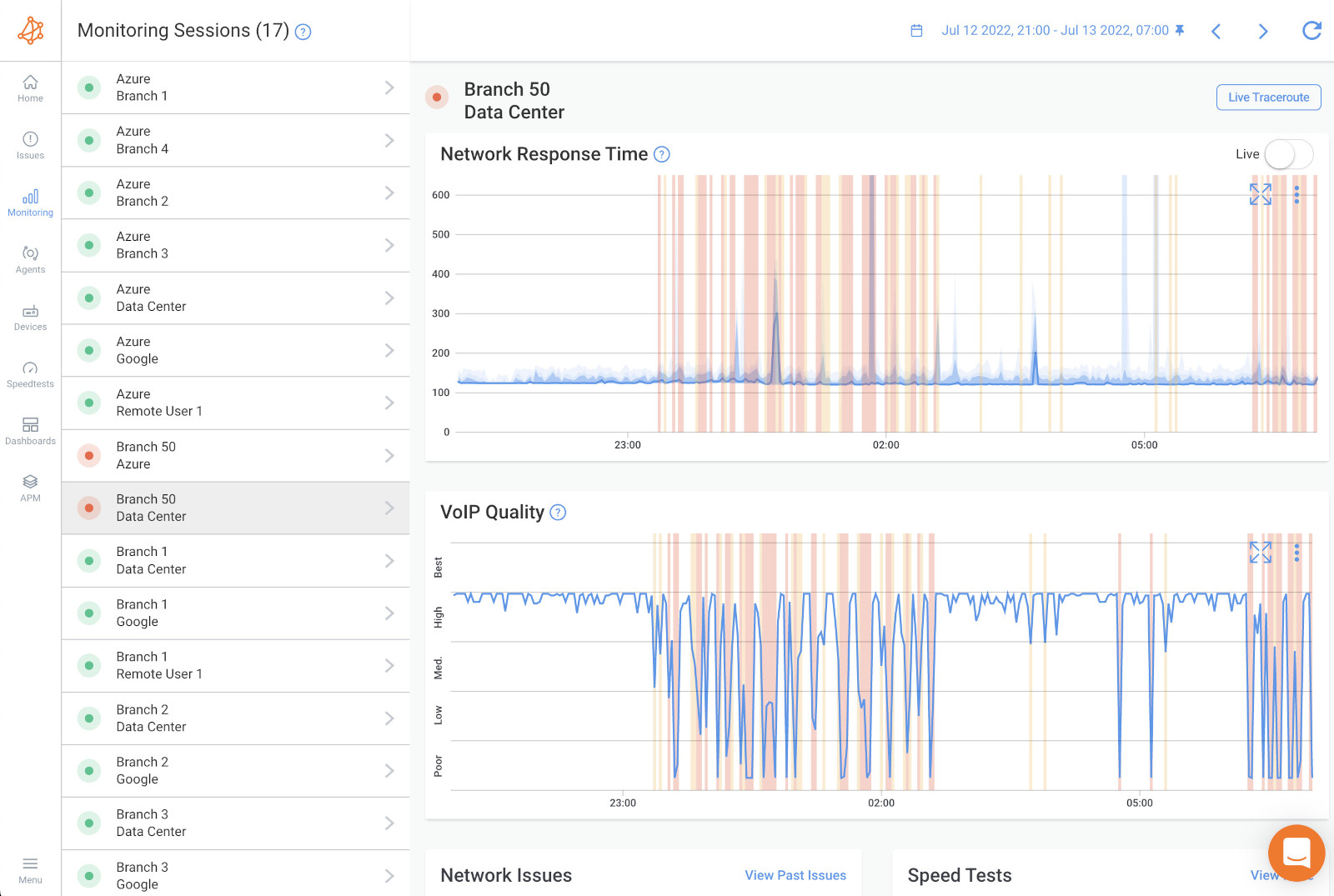
Measuring these network metrics allows you to quickly understand and identify any performance degradation in your network, which may be a sign of a network issue to come. Obkio provides updates on your network performance every minute - so you never miss problems. You can also analyze historical performance data to troubleshoot network issues from the past.
You can now use all the data you’ve collected to actually identify network problems and collect the information you’ll use to troubleshoot.
With Obkio, you can create your own dashboards and reports, get alerts for network issues, and use advanced tools like Obkio Vision: Visual Traceroute Tool to troubleshoot internally or externally with your Service Provider.
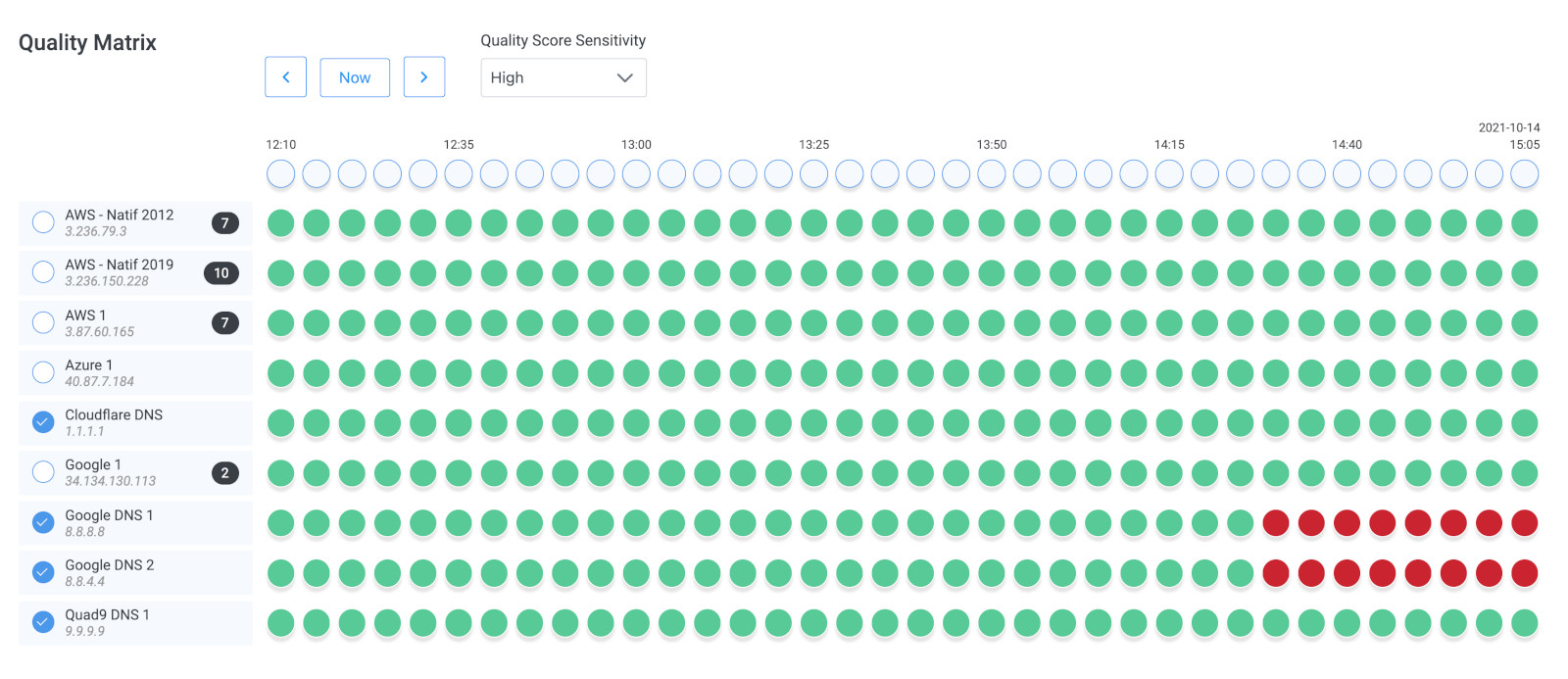
Concepts Related to Network Performance Monitoring: Network Availability, Network Uptime, Network Response Time
In the realm of Network Performance Monitoring (NPM), several key concepts play a pivotal role in assessing the health and efficiency of computer networks. In this section, we delve into three fundamental concepts closely related to NPM: Network Availability, Network Uptime, Network Response Time, Network Capacity, and Network Application Monitoring.
Understanding these concepts is essential for ensuring that networks remain accessible, reliable, and responsive, thereby delivering the high-quality performance that users and businesses depend on.
Network Response Time Monitoring is a specific aspect of Network Performance Monitoring (NPM). It focuses on measuring and analyzing the time it takes for data packets to travel from a source to a destination across a network, commonly referred to as "response time" or "latency."
Response time monitoring is a critical component of NPM because it provides insights into the network's speed and responsiveness, which can have a significant impact on the quality of network services and user experiences.
Measurement of Latency: Network Response Time Monitoring involves the continuous measurement of latency, which is the delay in data transmission. This delay can be caused by various factors, such as network congestion, routing inefficiencies, or the processing time at network devices (routers, switches, etc.). Monitoring latency is crucial because it directly affects the performance of real-time applications, such as video conferencing, online gaming, and VoIP.
Real-Time Monitoring: Like other aspects of NPM, Network Response Time Monitoring provides real-time data about network latency. This allows network administrators to identify and address latency issues as they occur. For example, if response times suddenly increase, it may indicate a network problem that needs immediate attention.
Alerting: NPM tools that include response time monitoring often have alerting mechanisms. When latency exceeds predefined thresholds, these tools can generate alerts, notifying IT personnel of potential issues. This enables proactive troubleshooting and minimizes the impact on network users.
Diagnosis and Troubleshooting: Monitoring response times helps in diagnosing the causes of latency. It can pinpoint where delays are occurring within the network, whether it's in a specific segment, a particular device, or due to increased traffic. This information is invaluable for troubleshooting and resolving performance bottlenecks.
User Experience Improvement: Network response time directly impacts the user experience. Slow response times can lead to frustration and reduced productivity for users. By monitoring and optimizing response times, NPM contributes to an improved quality of service and enhanced user satisfaction.
In summary, Network Response Time Monitoring is a crucial component of Network Performance Monitoring that specifically focuses on measuring the latency or response times within a network. It provides real-time data and insights to help maintain network responsiveness, diagnose issues, and enhance the overall network performance and user experience. It is one of the many facets of NPM that collectively ensure a network operates efficiently and effectively.
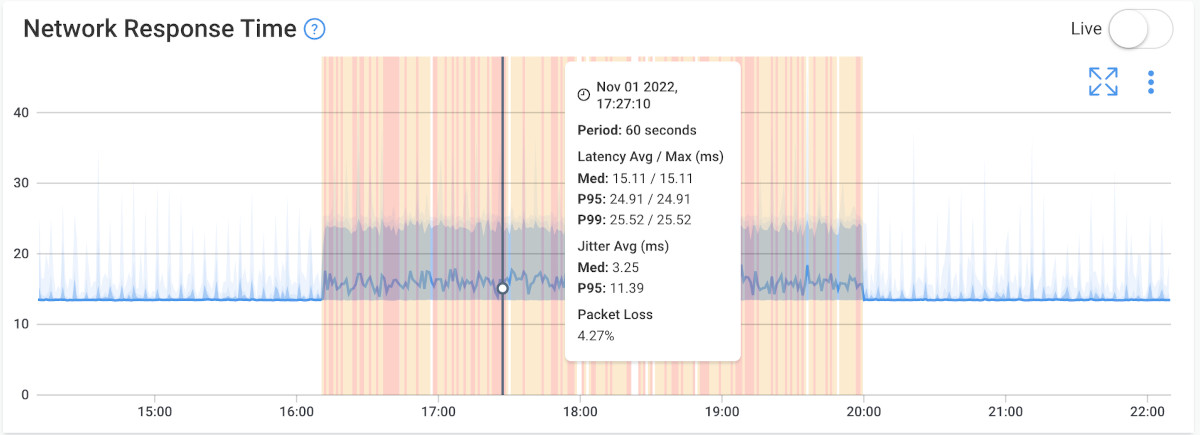
Network Availability Monitoring is a subset of Network Performance Monitoring (NPM) that specifically focuses on assessing the accessibility and uptime of network resources and services.
It involves monitoring the availability of network devices, services, and applications to ensure they are accessible and functioning as expected. Network Availability Monitoring is a critical aspect of NPM because it directly impacts the reliability and overall performance of a network.
Uptime Monitoring: Network Availability Monitoring primarily focuses on tracking the availability and uptime of network components, including routers, switches, servers, and critical services or applications. It continuously checks whether these resources are reachable and responsive.
Real-Time Monitoring: Similar to other NPM activities, Network Availability Monitoring provides real-time data about the status of network resources. It constantly checks the availability of devices and services and reports any outages, disruptions oe network disconnections as they occur.
Alerting and Notifications: Network Availability Monitoring tools often include alerting mechanisms. When a monitored resource becomes unavailable or experiences downtime, these tools can trigger alerts and notifications to inform network administrators or IT teams. This enables rapid response to address issues and minimize service disruptions.
Downtime Analysis: Availability monitoring helps in analyzing the causes of downtime or service interruptions. It can distinguish between network-related problems, hardware failures, software issues, or other factors that may affect resource accessibility.
Performance Impact: Network availability is closely related to network performance. Downtime or resource unavailability can significantly impact the performance and productivity of network users. By ensuring high availability, NPM indirectly contributes to maintaining optimal network performance.
Historical Data: Availability monitoring tools store historical data, allowing organizations to analyze uptime trends over time. This data is valuable for identifying patterns, planning maintenance, and making informed decisions about resource redundancy and network failover strategies.
In summary, Network Availability Monitoring is a vital component of Network Performance Monitoring that specifically focuses on ensuring the continuous availability and accessibility of network resources and services. It works in tandem with other aspects of NPM, such as latency monitoring, bandwidth utilization analysis, and security monitoring, to ensure that the network operates reliably and meets the needs of users and business operations.
By monitoring and maintaining high availability, organizations can minimize downtime and deliver a consistently high-quality network experience.
Learn what network availability is, how to use network availability monitoring to identify network performance issues vs. network availability issues.
Learn more

Next, related to the concept we just mentioned above, we have Network Uptime Monitoring. Network Uptime Monitoring is a specific aspect of Network Performance Monitoring (NPM) that focuses on measuring and ensuring the continuous availability and uptime of network resources and services.
It is a critical component of NPM because it directly affects the reliability and overall performance of a network.
Availability Tracking: Network Uptime Monitoring is concerned with tracking the availability and uptime of network components, such as routers, switches, servers, and services. It continuously checks whether these resources are online and functioning as expected.
Real-Time Monitoring: Similar to other aspects of NPM, Network Uptime Monitoring provides real-time data about the status of network resources. It constantly checks the availability of devices and services and reports any outages or disruptions as they occur.
Downtime Analysis: Availability monitoring helps in analyzing the causes of downtime or service interruptions. It can distinguish between network-related problems, hardware failures, software issues, or other factors that may affect resource accessibility.
Performance Impact: Network uptime is closely related to network performance. Downtime or resource unavailability can significantly impact the performance and productivity of network users. By ensuring high uptime, NPM indirectly contributes to maintaining optimal network performance.
Historical Data: Uptime monitoring tools store historical data, allowing organizations to analyze uptime trends over time. This data is valuable for identifying patterns, planning maintenance, and making informed decisions about resource redundancy and failover strategies.
In essence, Network Uptime Monitoring is a crucial component of Network Performance Monitoring, ensuring that network resources and services remain continuously available and reliable. It works in conjunction with other NPM activities, such as latency monitoring, bandwidth utilization analysis, security monitoring, and more, to maintain a network that operates consistently and meets the needs of users and business operations.
By monitoring and maintaining high uptime, organizations can minimize downtime, deliver a consistently high-quality network experience, and maximize the productivity of network users.
Network Capacity Monitoring is another aspect of Network Performance Monitoring (NPM) that focuses on assessing and managing the network's capacity to handle data traffic effectively. It involves monitoring and analyzing network bandwidth, throughput, and resource utilization to ensure that the network can accommodate current and future demands.
Network Capacity Monitoring is closely related to NPM because it plays a pivotal role in maintaining optimal network performance and user satisfaction.
Bandwidth Utilization: Network Capacity Monitoring involves continuous monitoring of the network's bandwidth utilization. It tracks how much of the available network capacity is currently in use and identifies trends in traffic patterns.
Resource Optimization: By assessing network capacity, Capacity Monitoring helps in optimizing resource allocation. It enables network administrators to allocate bandwidth more efficiently to ensure critical applications receive adequate resources while minimizing congestion.
Performance Impact: Network capacity directly impacts network performance. If a network becomes congested due to insufficient capacity, it can result in slowdowns, latency, packet loss, and degraded user experiences. Capacity Monitoring helps prevent such issues.
In summary, Network Capacity Monitoring is an integral component of Network Performance Monitoring, focusing on the network's ability to handle traffic effectively and efficiently. It works in conjunction with other NPM activities, such as latency monitoring, availability monitoring, security monitoring, and more, to ensure that the network operates optimally and meets the needs of users and business operations.
Network Application Monitoring is a specialized subset of Network Performance Monitoring (NPM) that focuses on the health and performance of individual networked applications and services. It involves monitoring and analyzing the behavior, availability, and responsiveness of specific applications to ensure they operate efficiently and deliver a high-quality user experience.
Network Application Monitoring is closely related to NPM because it provides insights into how applications and services are performing on the network, which is vital for overall network performance assessment.
Application-Specific Monitoring: Network Application Monitoring specifically targets individual applications and services running on the network. It collects data about how these applications are behaving, such as response times, error rates, and resource utilization.
Real-Time Monitoring: Like other NPM activities, Network Application Monitoring provides real-time data about the performance of applications. It continuously tracks the responsiveness and availability of applications, ensuring that issues are identified promptly.
User Experience: Application performance directly impacts user experience. Network Application Monitoring helps assess whether applications are meeting user expectations, and it can detect issues affecting application response times or functionality.
Diagnosis and Troubleshooting: When application-related problems occur, Network Application Monitoring aids in diagnosing the root causes. It provides insights into whether issues are due to network problems, server issues, application code, or other factors.
Resource Allocation: Monitoring application performance helps in resource allocation and optimization. Organizations can allocate network resources and server capacity based on the demands of critical applications, ensuring they receive the necessary resources for optimal performance.
In summary, Network Application Monitoring is a critical component of Network Performance Monitoring, specifically focusing on the health and performance of individual applications and services on the network. It works alongside other NPM activities, such as latency monitoring, capacity monitoring, security monitoring, and more, to ensure that both the network and its applications operate optimally.
By monitoring application performance, organizations can proactively address issues, enhance user satisfaction, and maintain the overall health of their networked applications.

In recent years, advances in technology and changes in the way that organizations use networks have led to new trends in network performance monitoring. So let’s explore some of the key trends in network performance monitoring and how they are shaping the way that organizations approach network performance monitoring.
SD-WAN promises improved performance for enterprise networks. With the popularity of cloud-based applications, businesses are more reliant than ever on the Internet to deliver WAN traffic. As a result, they’re migrating from MPLS networks to hybrid networks and WAN architectures and SD-WAN (Software-Defined Wide Area Networking) networks and monitoring SD-WAN networks.
Cloud-Based Apps are being increasingly adopted by businesses of all sizes. This new shift also requires businesses to turn to SaaS or cloud-based network performance monitoring tools to properly monitor cloud-based applications.
Multi-Cloud environments are becoming more common, requiring network performance monitoring tools that can monitor performance across multiple cloud providers and environments.
End-to-End Network Visibility is becoming more important as organizations look to gain visibility into network performance across all layers of the network stack. This increases our reliance on monitoring solutions that can monitor all network locations for end-to-end network visibility.
Distributed Networks are replacing traditional centralized architectures. That’s because distributed networks can better support the increasing use of cloud-based services and SaaS apps. Because of this, distributed network performance monitoring tools are becoming more important.
Real-Time Network Analytics are becoming more important as organizations look to gain real-time insights into network performance and respond to issues in real-time.
Wi-Fi Performance Monitoring is becoming more important as the use of Wi-Fi networks becomes more widespread in both enterprise and consumer settings.
Artificial Intelligence (AI) and Machine Learning (ML) are being used to automate network performance monitoring tasks and provide real-time insights into network performance.
Security-Focused network performance monitoring is becoming more important as organizations look to detect and respond to security threats in real-time.
The Internet of Things (IoT) is driving the need for network performance monitoring tools that can handle the high volume of devices and data generated by IoT devices.
The Rollout of 5G Networks is increasing the need for network performance monitoring tools that can monitor the increased bandwidth and latency requirements of 5G networks.
Software-Defined Networking (SDN) is changing the way networks are managed and monitored, requiring new tools and approaches to network performance monitoring.
Explore real use cases of how Obkio revolutionizes SMB network monitoring, enhancing efficiency, and delivering top-notch user experiences.
Learn more

Now that we’ve gone through everything you need to know about network performance monitoring, it’s pretty clear to see why it’s the Gandalf of networks, saving networks from performance and availability issues, saving end-users from poor performance and businesses from lost time and money.
Whether you're monitoring network performance to improve security, optimize resources, or reduce costs, the power of network performance monitoring cannot be underestimated. Whatever the size and scope of your business, and whatever network types you use, network performance monitoring is important for providing critical insights into network behavior and helping network administrators identify and resolve issues before they can cause downtime or impact the user experience.
So, let us embrace the magic of network performance monitoring, and may it guide us through the darkest of network issues and ensure that our networks always perform at their best!

Stop looking for a Network Performance Monitoring tool
Networks may be complex. But Obkio makes network monitoring easy. Monitor, measure, pinpoint, troubleshoot, and solve network problems.
- 14-day free trial of all premium features
- Deploy in just 10 minutes
- Monitor performance in all key network locations
- Measure real-time network metrics
- Identify and troubleshoot live network problems



























 Obkio Blog
Obkio Blog












